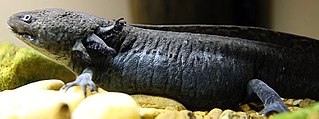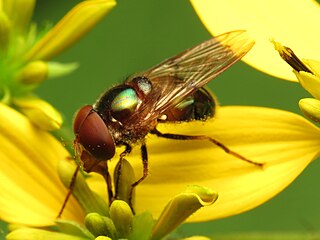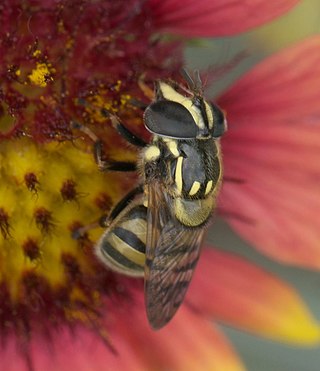
The axolotl is a paedomorphic salamander closely related to the tiger salamander. It is unusual among amphibians in that it reaches adulthood without undergoing metamorphosis. Instead of taking to the land, adults remain aquatic and gilled. The species was originally found in several lakes underlying what is now Mexico City, such as Lake Xochimilco and Lake Chalco. These lakes were drained by Spanish settlers after the conquest of the Aztec Empire, leading to the destruction of much of the axolotl’s natural habitat.

Campiglossa is a genus of fruit flies in the family Tephritidae. There are at least 190 described species in Campiglossa.

Copestylum is one of the largest genera of hoverflies in the Americas. It comprises more than 300 species, of which only four have been found outside the Americas, having probably been introduced by the importation of cacti in which the larvae live.
Copestylum florida is a species in the family Syrphidae, in the order Diptera ("flies"). The species is known generally as the Florida bromeliad fly.

Bolbocerosoma is a genus of earth-boring scarab beetles in the family Bolboceratidae. There are about 13 described species in Bolbocerosoma.
Euphranta canadensis, the currant fruit fly, is a species of fruit fly in the family Tephritidae.

Copestylum violaceum, the purple bromeliad fly, is a species of syrphid fly in the family Syrphidae.
Copestylum fornax is a species of syrphid fly in the family Syrphidae.
Copestylum anna, or Anna's bromeliad fly, is a species of syrphid fly in the family Syrphidae.

Copestylum vesicularium, the irridescent bromeliad fly, is a species of syrphid fly in the family Syrphidae. This species is widely distributed on the eastern half of North America.
Copestylum macrocephalum is a species of syrphid fly in the family Syrphidae.This species has been observed in Mexico (Baja), California,and Arizona.
Copestylum caudatum, the hairy-horned bromeliad fly, is a species of syrphid fly in the family Syrphidae.
Copestylum comstocki, or Comstock's bromeliad fly, is a species of syrphid fly in the family Syrphidae.

Copestylum vittatum, the striped bromeliad fly, is a species of syrphid fly in the family Syrphidae. It is widely distributed in North America.
Copestylum satur, the spotted-wing bromeliad fly, is a species of syrphid fly in the family Syrphidae.
Copestylum haagii, or Haag's bromeliad fly, is a species of syrphid fly in the family Syrphidae. They have been found in Western North America.
Copestylum lentum is a species of syrphid fly in the family Syrphidae They have been observed in California, Colorado, New Mexico, Arizona, Texas and Mexico.
Copestylum tamaulipanum is a species of syrphid fly in the family Syrphidae.

Copestylum barei, the violet bromeliad fly, is a species of syrphid fly in the family Syrphidae.

Copestylum marginatum is a species of syrphid fly in the family Syrphidae. This species has been observed in Southwestern North America.









